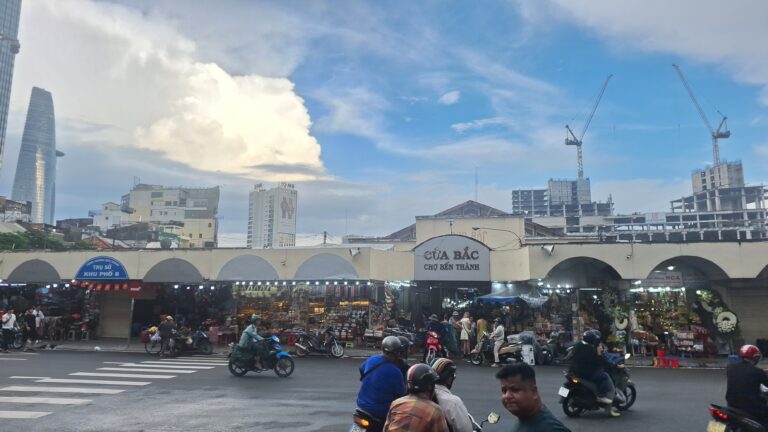
Home > Blog > Travel Guides > Motorbike Routes in and Around Da Lat
Motorbike Routes in and Around Da Lat
Share:
- Published:
- Updated: 20/01/25

Da Lat is a city in Vietnam’s Central Highlands and has earned a reputation as a popular destination for locals and foreigners alike. Its elevation makes it unique in Vietnam in many ways, including climate and its surrounding flora. Essentially, if you’re trying to beat the heat so common to other parts of Vietnam, Da Lat makes for a welcome escape.
It was, in fact, Da Lat’s unique climate that drew the attention of the French, who developed the area as a resort destination in the 1890’s. It survived the war without significant damage, so much of its colonial heritage remains intact. Its architecture and climate contribute to its charm, drawing tourists year-round.
The city and its surrounding region also boasts some of the country’s best roads and best scenery. In addition to being a major agricultural hub, it’s famous for its pine trees and nearby mountain peaks reaching to 2,500 meters. Some of the roads in this region are truly breathtaking and are certainly capable of vying for the title of the best road in Vietnam.
Table of Contents
Routes Around Da Lat
Although the Hai Van Pass is widely considered the most iconic road in Vietnam, the Khanh Le Pass road rivals it for fun and spectacular views. Route 27C runs north out of Da Lat before turning northeast and heading towards Nha Trang. The road itself is around 120 km long and manages a spectacular climb from sea level up to 1600 meters. It’s fairly new and is in excellent condition. And it’s built like a racetrack: with ultra-tight hairpin turns, sweeping curves, and enough straightaways to get up to good speeds, this road is a guaranteed winner. Only the dead could be bored here.
The road itself is awe-inspiring, but the scenery surrounding it adds to the wow factor. Stunning vistas of unspoiled forests, rugged mountains, sweeping valleys, dazzling waterfalls, and local villages and farms will impress even the most stoic traveller.
Da Lat from Saigon
For those heading to Da Lat from Saigon, a popular route is to cut southeast of the city and follow the coast past Ba Ria towards Phan Thiet—often known to travellers as Mui Ne, one of the kitesurfing meccas of the world. From Phan Thiet, a series of highways cut north towards Da Lat, and any of them can make for a fun ride through the countryside. For those who feel like a bit of a wander, the highways are bisected and connected by smaller, more rural roads that lend themselves to some peaceful, bucolic scenery.
Riders may wish to avoid the main highways from Saigon to Da Lat, as they’re often jam-packed with trucks and buses pulling daring passes and other stunts while blowing dust in your face. Smaller roads lend themselves to a more fun and authentic-feeling trip.
Another possible route is to cut northeast of Saigon before snaking through Cat Tien national park, renowned for its old-growth forest and indigenous wildlife. The road continues to climb through Bao Loc, a city in the highlands renowned for its lakes, before making its way to Da Lat.
Da Lat itself is full of small back roads that provide some truly stunning scenery. South of town is Tuyen Lam lake, ringed by roads and some resorts. This road would make for an excellent evening drive with a stop for a coffee or meal at one of its many viewpoints and eateries.
The DT722
Another road worth seeing is the DT722. Running north out of Da Lat, it winds and climbs through mountains and pine forests before dead-ending at the border of nearby Dak To province. At roughly 110 kilometers round-trip, the ride can be accomplished in a day, though visitors may wish to spend a night camping or in one of the few guest houses on the route.
Besides these, there are countless back roads, dirt tracks, and alleys that make Da Lat an adventure rider’s paradise perfect for different motorbike routes. Our guides know them well—you will not leave with sore eyes.
Driving in Da Lat
Because Da Lat itself is at 1,500 meters and the surrounding area can be up to 2,500 meters, it’s significantly cooler than the rest of the country. In the hottest part of the year, it’s a good 10 degrees or more cooler than the lowland areas. A person who goes for motorbike routes from Saigon or Nha Trang to Da Lat, for example, would find the air quite refreshing in the hot months.
The city rarely gets above 30 degrees celsius, and from October to March it can be quite cool indeed. Visitors can expect temperatures in the teens celsius most of the time, though the weather can warm significantly during the day. The city also experiences plenty of rain and humidity, so it’s best to be prepared for wet weather conditions at any time of year, but especially during the summer.
Because of its unique climate in Vietnam, riders will need to dress differently than they would in other parts of the country. Cold weather and especially wet weather gear will be a necessity when traveling through the central highlands, though it may not be necessary at all times.
The unpredictable nature of the weather at this elevation leads to showers appearing essentially out of nowhere, so it’s best to keep a good wet weather riding jacket and some wet weather pants handy in case you need to stop and change.
Da Lat Highlights
Da Lat motorbike routes uniqueness and overall beauty have cemented its reputation as one of the premier tourist destinations in the country, especially for locals. In fact, it’s become the ‘honeymoon capital’ of the country, and hearts are plastered all over the city. Perhaps you find that charming or perhaps you find that cheesy, but there’s a lot to see in the city and around it.
Da Lat Farms

As one of the premier agricultural areas of the country, Da Lat’s farms and plantations attract lots of visitors. The city’s elevation allows it to grow very different crops than can be found in the lowlands. Indeed, driving into the city from any direction, visitors can see greenhouses scattered across the horizon as far as the eye can see.
Westerners may be surprised to see very familiar vegetables and fruits. For example, Da Lat is famous for its strawberries, and the strawberry farms themselves are a tourist attraction for many Vietnamese. Because strawberries are rare in Southeast Asia, many locals are curious as to how they grow. Da Lat produces most of the cold-weather vegetables available in Vietnam, including leafy greens, broccoli, and artichokes. Visitors can also enjoy Da Lat’s unique artichoke tea, as well as a variety of other teas.
Similarly, Da Lat produces a huge variety of flowers that it exports to the rest of the country. A visit to a flower farm can be a refreshing and enlightening stop in this already-lush area.
Those who can’t start the day without their cup of morning joe will be pleased to know that Da Lat is one of the premier coffee-growing regions in the country. Fun fact: Vietnam is the second-largest coffee producer in the world, after Brazil. A huge amount of that coffee is consumed in-country. Consequently, saying there’s an abundance of coffee shops is an understatement. They’re on every corner and found in every nook and cranny of the country, and especially this city.
Da Lat is also famous for its ‘weasel coffee’ which is, by the way, not actually produced using a weasel but a civet. Though the process may sound icky—coffee beans are fed to the civet before being extracted from their dung, washed, and roasted—the coffee has made a name for itself as a delicacy. At the time of this writing, this writer has not yet tried it but hey, fortune favors the bold so give it a go.
Da Lat Architecture

Da Lat was built by the French, and its architecture speaks to its heritage. It was also fortunate to survive the previous war without significant damage, so many of its old buildings remain intact. The city also features notable standout buildings and more modern influences. These buildings add to the city’s charm and unique, eclectic appeal.
In addition to its French architecture, Da Lat has some notable tourist attractions—for example, its famous ‘Crazy House’. If you’re interested, you can even book a room in the crazy house, though be prepared for hordes of tourists outside snapping photos.
Da Lat Waterfalls
Da Lat is indeed famous for its waterfalls. Many of these falls, however, have been overrun by tourists in recent years and are a shadow of their former selves. Cam Ly waterfall, for example, has suffered the price of fame and is sadly polluted.
Plenty of other waterfalls, however, are further afield and are rarely visited. Many of them are free to visit and may be entirely tourist-free. A good rule of thumb is the further out the waterfall, the fewer the tourists and the better shape the waterfall is in.
Onyabike Adventures’ Thoughts
Da Lat is one of the premier motorcycle adventure tour destinations in Vietnam and indeed of all southeast Asia. Its great roads, unique climate, and diverse array of outdoor activities make it a perfect spot to include on any trip. Whichever direction you’re heading, be sure to not give Da Lat a miss.
Recent Posts






